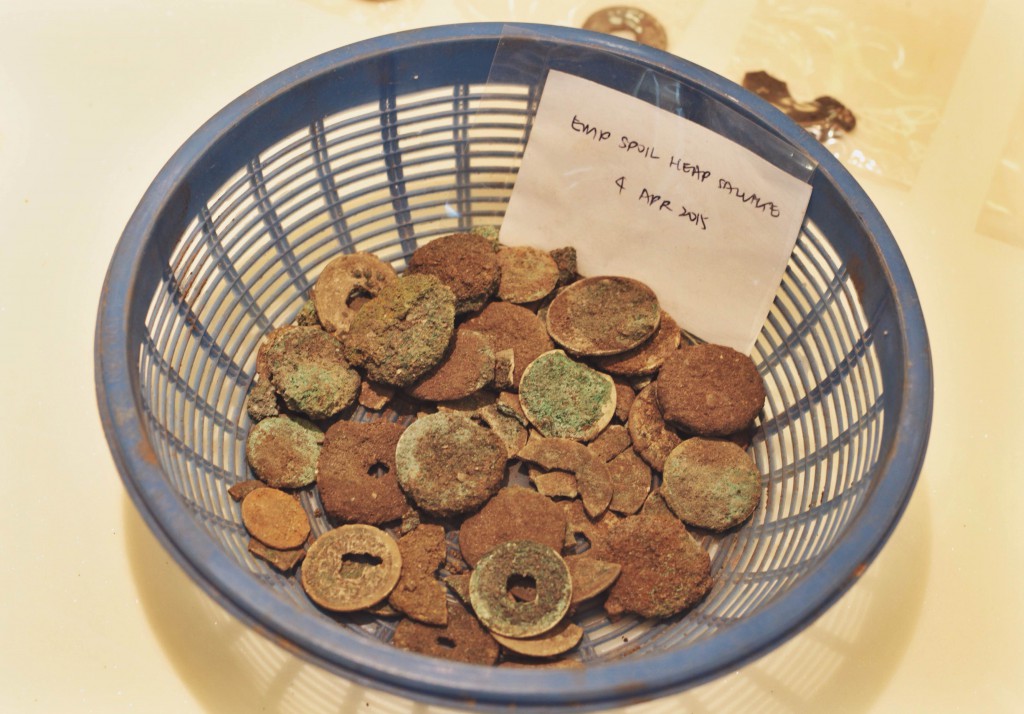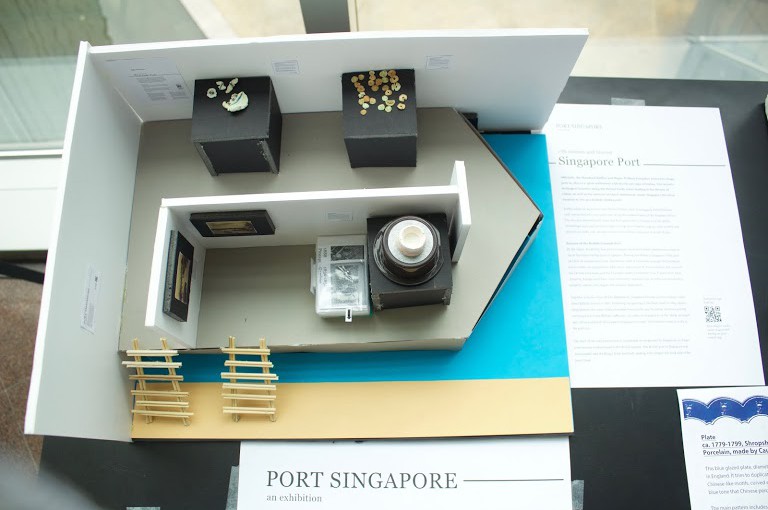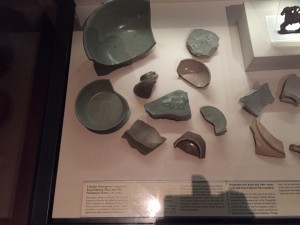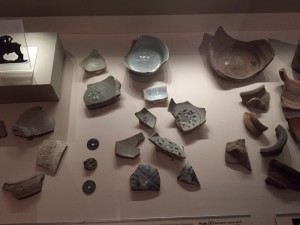For easy references. Draft 2.
Chinese Copper Coins

Chinese Copper Coins
Singapore (Temasek), 14th – 15th century
Currently in the possession of NUS museum
Excavated from Fort-canning Park, Empress Place, and Singapore River, these ancient coins originated from ancient China. They were the ancient currency of Singapore and were used in trade when the Chinese came to Singapore. Archaeologist Lim Chen Sian once jokingly referred to these coins, saying, “Why bother to produce copper coins when you can get them from China?”
The origins of these coins vary between several dynasties, suggesting that well-established trade had been on-going between Singapore and China long before the British colonised Singapore.
Previous and later excavations have revealed coins originating from other countries, including Sri Lanka and Indonesia. This discovery further supports the theory that Temasek was once a boisterous and successful trading port during the 14th century and was well-connected to the countries around her.
[edited for grammar]
It is interesting to note that from current evidence, it would appear that Temasek was engaged in trade mostly within Southeast Asia, and with China.
Wall Poster: Ancient Chinese Coins and Temasek’s Trade with China
While a large number of ancient Chinese copper coins have been recovered from recent excavations in Singapore, we still know very little about them as they are still being studied and analyzed. However, this is still a huge discovery to Singapore’s history.
Although most Singaporeans are familiar with Sang Nila Utama, supposed founder of Singapura, he is often dismissed as part of a legend and myth, deemed as mere fiction and not history. This is partly due to the over exaggerated nature of the story of Singapura’s founding, and partly due to the fact that lions (, the namesake of Singapura,) have never existed in Southeast Asia, and thus throws the story’s credibility in doubt. Thus, most of the credit of founding Singapore is attributed to Sir Stamford Raffles instead. Singapura is then perceived to have been a “sleepy fishing village” before the British colonialism.
However, a small number of records speak of Temasek, an urban city of its time, teeming with trade. According to the legend, Temasek was the name of Singapore, before it was named Singapura. With the discovery of these ancient currencies and other aretfacts, it slowly becomes evident that Singapura was indeed bustling with trade, even before the arrival of Sir Stamford Raffles.
As we wait for more in-depth analysis of these coins to be completed, we can still derive much information from these coins. There are a variety of coins, each originating from a different dynasty. Current research suggests that the coins originate from the Tang dynasty, Jin dynasty, Song dynasty and Yuan dynasty of China. The existence of these coins suggest that the Chinese have set foot in Singapura, and that they brought money with them, presumably for trade. Also, considering the large number of coins that were preserved until now, it implies that there were a lot of these currency going around Singapura. Furthermore, seeing that these coins span across dynasties, we can tell that trade in Singapura was well-established, stretching across time.
The distance between Singapore and China is considerable, and with the amount of evidence of trade with the Chinese, we can estimate a large amount of interaction between Singapura and China. Such large amounts of prolonged interaction is not by coincidence, but rather suggests a deliberate effort of the Chinese to travel down to Singapore, carrying their goods and money with them. All these evidence point towards the existence of Temasek, the bustling trading port of ancient Singpura. Even though there are few records of Temasek, it is interesting to note that Chinese records acknowledge that Sang Nila Utama was the ruler of Singapura, suggesting that China had relations with Singpura at that time.
Catalogue: Ancient Chinese Copper Coins
Catalogue: Ancient Chinese Copper Coins
Recently, intense excavations have been carried out by a small team of four in Singapore. From their excavations, the team recovered several tonnes of priceless artefacts, datable back to the 14th century. This discovery has been an important one to the history of Singapore, especially as Singapore’s government has little to no focus on archaeology in Singapore. Due to Singapore’s lack of focus on archaeology, land in Singapore has been extensively developed, disturbing the soil beneath, and damaging, if not destroying, any possible artefacts that lay buried. Thus, these excavations have been regarded as great successes for merely being able to reach an undisturbed layer of soil, let alone for the amount of artefacts that were recovered.
The excavation sites, Empress Place and Fort Canning Park are both thought to be prime areas in the past. Empress Place was the location of a thriving port along the Singapore River, while Fort Canning Park is thought to have had a royal palace on its summit. Both sites have revealed a sizeable number of artefacts and evidence for the claim that Singapura was once a thriving port-city, even before the arrival of the British.
From Fort Canning Park alone, a number of luxury and exotic good were uncovered, revealing that there was an elite class that lived on the hill during the 14th Century. Amongst these artefacts, exquisite Chinese ceramics, Indian glass beads and gold ornaments have been recovered. Nearer the foot of the hill, artefacts uncovered were of lower grade and quality, further suggesting that while the elite stayed on the summit of Fort Canning Park, the middle-class men stayer at the foot. Not only that, but the presence of exotic goods are evidence of trade during the 14th Century.
From Empress Place, around 400 kilograms worth of artefacts were recovered in Febuary 2015 alone, including artefacts of earthenware, animal figurines and rare Buddhist figurines. Much of the artefacts recovered are broken ceramic shards, hinting that they were literally trash of the 14th century. Archaeologist Lim Chen Sian suggests that the area was possibly a bazaar or marketplace, saying that it was unlikely that there would so much trash if it were a residential zone.
Ancient Chinese copper coins were also recovered from Empress Place. The origins of these coins vary, and research has suggested that they originate from the Tang dynasty, Jin dynasty, Song dynasty and Yuan dynasty in China. These coins are evidence that the Chinese have travelled from China to Singapura, and that they brought money while travelling down to Singapura. On top of this, the existence of different coins across different dynasties suggest that this practice was a prolonged one and that it was a continuous practice to travel down to Singapura to do trade. With recent excavations revealing the sheer amount of coins preserved, it would not be a stretch to suggest that trade was very well-established and boisterous during the 14th century. This is especially so considering that much of these ancient coins probably no longer exist, since there have been artefacts uncovered of copper coins partially melted by heat. This possibly indicates a practice of recycling copper coins, melting them and using them instead as materials instead.
It would have taken tremendous effort for the Chinese to travel down from China to Singapura, so it could be suggested that Singapura had something extremely desirable for China. However, modern day Singapore is a small island city, surrounded by waters, with little to no natural resources. Ancient Singapura would likely face this very same problem of minimal natural resources. Taking into account of previously mentioned artefacts of Indian glass beads and other exotic goods, it is most likely that the Chinese came down to Singapura for its trading ports, and to trade with other countries that stoppped by.
Other ancient coins originating from other countries have also been excavated from Singapore, including a Kupang(Indonesian) coin. Coins from Sri Lanka have also been found. These evidences suggest that Singapura’s trade was mostly within Southeast Asia, and with China and India. Although Singapura’s trade was well-established, they had little to no contact with the European countries during that time.
Considering that serious excavations have only just started in Singapore, it is very likely that much of the information we have of Singapura now is still limited and on the surface. With further excavations, we will probably have greater insights into Singapore before colonialism, and we will get a clearer picture of what ancient Singapura the trading port was like.
Bliblography
Archaeological dig at Singapore’s Empress Place uncovers tonnes of artefacts. (n.d.). Retrieved November 16, 2015, from https://sg.news.yahoo.com/photos/archaeological-dig-at-singapore-s-empress-place-uncovers-tonnes-of-artefacts-slideshow/gold-coin-kupang-from-the-15th-century-uncovered-at-singapore-s-empress-place-archaeological-photo-1429175418648.html#thumbnails-view
Archaeologists find 700-year-old relics at Empress Place. (n.d.). Retrieved November 16, 2015, from http://news.asiaone.com/news/singapore/archaeologists-find-700-year-old-relics-empress-place
Archaeology of the “Forbidden Hill” – Singapore History. (n.d.). Retrieved November 16, 2015, from http://eresources.nlb.gov.sg/history/events/2ebfebad-a4d5-4bbb-bf43-c7db6e30eb7d
Dig into past at Empress Place uncovers 700-year-old artefacts. (2015, February 13). Retrieved November 16, 2015, from http://www.straitstimes.com/singapore/dig-into-past-at-empress-place-uncovers-700-year-old-artefacts
Digging up Singapore’s history. (2015, February 20). Retrieved November 16, 2015, from http://www.straitstimes.com/opinion/digging-up-singapores-history
Empress Place dig yields ‘excavation jackpot’ with 2.5 tonnes of artefacts. (n.d.). Retrieved November 16, 2015, from http://www.channelnewsasia.com/news/singapore/empress-place-dig-yields/1787534.html
Southeast Asian Archaeology :: Archaeology in Singapore :: Fort Canning. (n.d.). Retrieved November 16, 2015, from http://www.seaarchaeology.com/v1/html/sg/fort_canning.html
Southeast Asian Archaeology :: Archaeology in Singapore :: Padang. (n.d.). Retrieved November 16, 2015, from http://www.seaarchaeology.com/v1/html/sg/padang.html
What was Singapore LiKE before 1819? – Infogram, charts & infographics. (n.d.). Retrieved November 16, 2015, from https://infogr.am/cheongster_1410420932
World of Temasek. (n.d.). Retrieved November 16, 2015, from http://www.worldoftemasek.com/index.php/article/archaeology
World of Temasek. (n.d.). Retrieved November 16, 2015, from http://www.worldoftemasek.com/index.php/article/people



